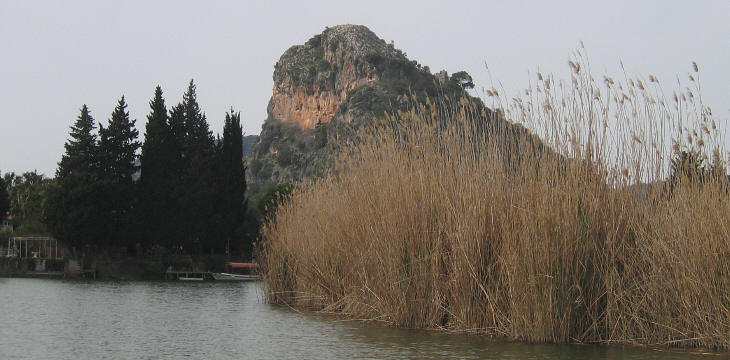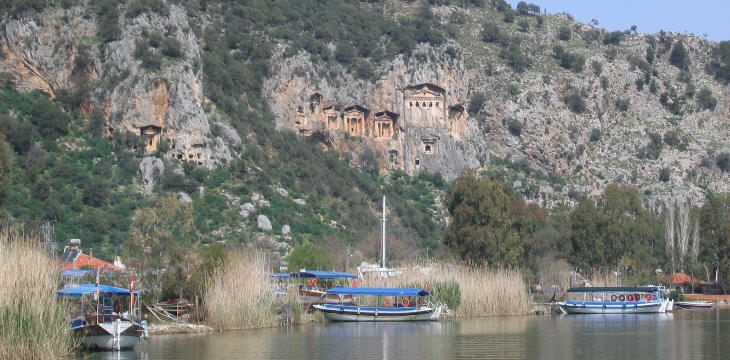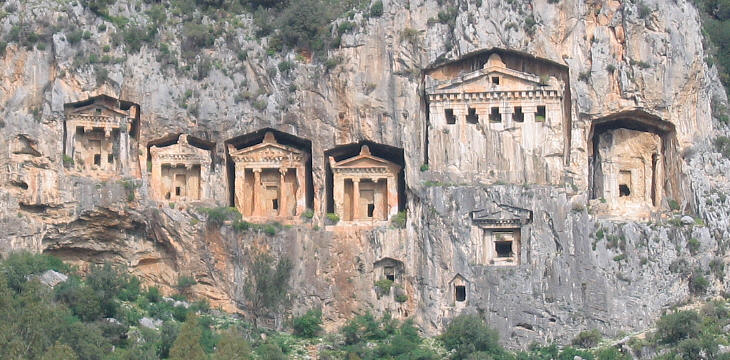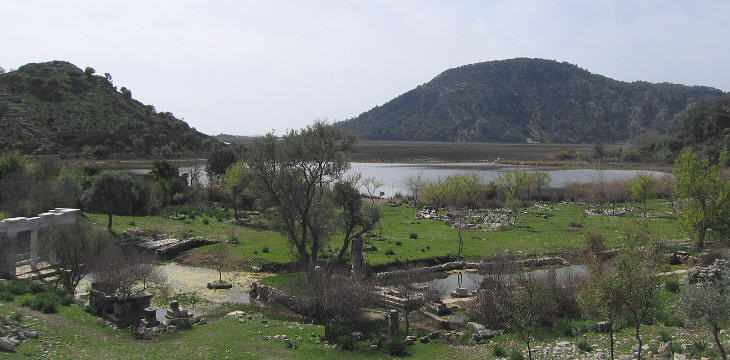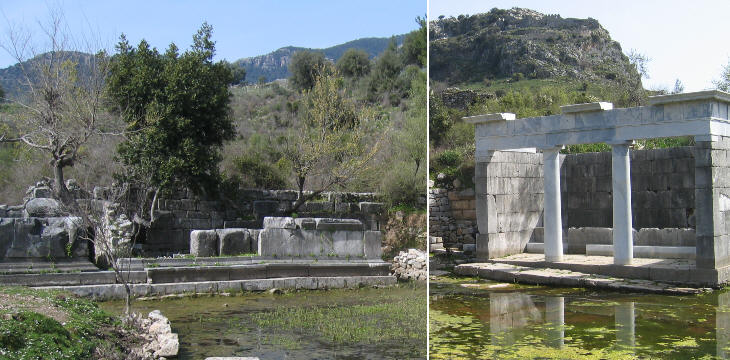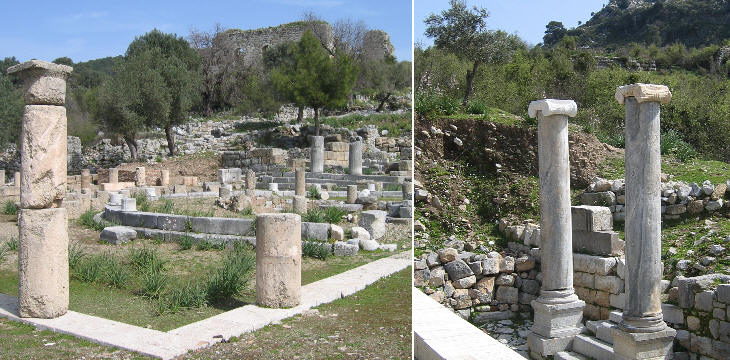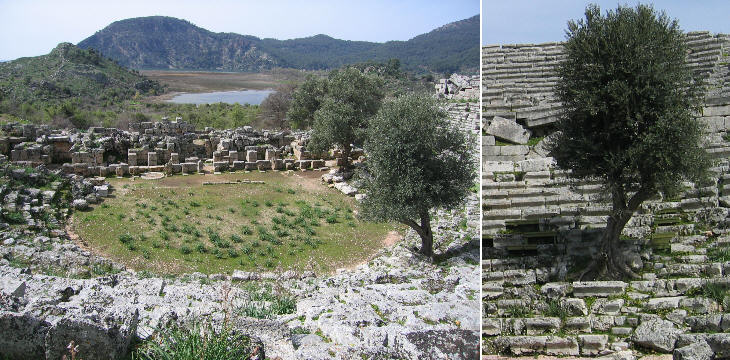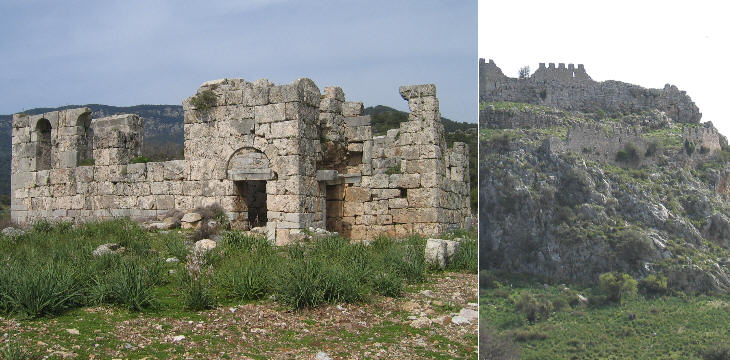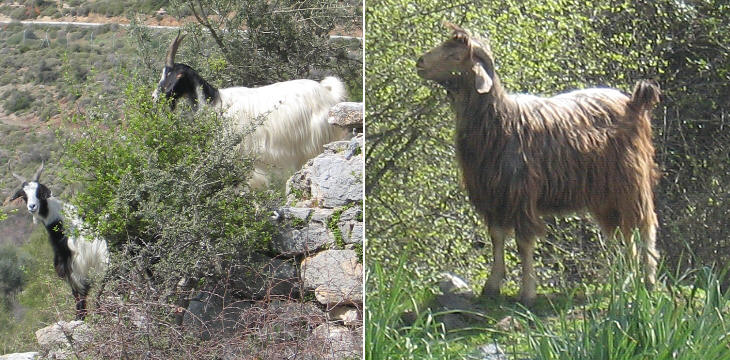  What's New! Detailed Sitemap All images © by Roberto Piperno, owner of the domain. Write to romapip@quipo.it. Text edited by Rosamie Moore. Page added in May 2008. |
 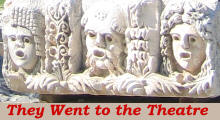 - Kaunos - Kaunos(Theatrical masks at Myra) The ancient town of Kaunos (or Caunos) was located near the coastline on an isolated rocky hill which was surrounded by marshes. According to the geographer Strabo (63 BC- 24 AD), "the people of Kaunos are pitifully unhealthy and the duration of their lives is as short as leaves". However the shallow waters near Kaunos were a source of fish and salt, so that the town prospered by trading them. In addition its figs were renowned and were exported to Rome.
The first appearance of the acropolis behind a reed bed is stunning: it is a view which has become very popular with the growth of Mediterranean cruises. Many ships call at Marmaris, a port opposite Rhodes, and their local agents organize excursions to Kaunos. Buses stop at Dalyan, a modern town, where day trippers are serviced by a small fleet of low boats which carry them to the archaeological site.
Large crowds visit Kaunos, not so much for its archaeological area, but rather for a spectacular series of rock-cut tombs along sheer cliffs between Dalyan and Kaunos.
Kaunos was located in the historical region of Caria near the border with Lycia. Its kings and most prominent citizens built their tombs the way Lycians did. The smaller tombs are the older ones: their design was inspired by the timber houses where the inhabitants of Kaunos lived; at a later period tombs became larger and were shaped as small temples. All tombs have been desecrated by robbers in search of jewels and funerary objects.
The site of the ancient harbour is still easily visible, but its current name Suluku Golu (Pond of the leeches) tells that it is no longer directly linked to the sea. It was a very well protected harbour: its entrance could be closed with chains if needed.
Most of the buildings next to the harbour belong to the Roman period; archaeologists have found many inscriptions in praise of the Roman proconsuls of Asia and of the emperors. Most likely during the Ist century AD a person named Quintus Vedius built a large fountain; a nearby small temple (partially reconstructed) was built at the same time.
Kaunos retains evidence of a very ancient sacred area: it consisted of a tholos (circular temple) surrounded by a square portico. The Doric columns of the latter were made up of roughly cylindrical stones which were covered with plaster to hide their faults. During the Roman period other temples were built near the sacred area; their perfect columns had shafts of cipollino (green marble from Euboea) or of Egyptian granite and white marble capitals.
The ancient theatre of Kaunos was built by excavating the slope of the hill; it was enlarged during the Roman period by the addition of other rows of seats and underground galleries which gave access to them. The members of the audience who were bored with the play could spend their time enjoying the view of the harbour and of the sea.
The wealthiest citizens of Kaunos had a rest or exercised in large baths built during the Roman rule. Their strongly built walls have withstood the ravages of time. A certain number of altars have been arranged in the calidarium, the main hall of the baths.
Kaunos retained some importance also during the Byzantine period: a relatively large church was built in the upper part of the town. In an attempt to protect the inhabitants from Arab raids the ancient acropolis was fortified. However the silting of the harbour led to the abandonment of the town.
Introductory page Miletus Priene Didyma Euromos Iasos Milas Telmessos Tlos Xanthos Letoon Patara Antiphellos Simena Myra Phaselis Termessos Attalia (Antalya) Perge Aspendos Side Map of Turkey with all the locations covered in this website   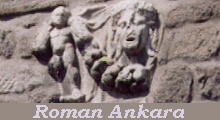 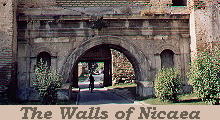 |
